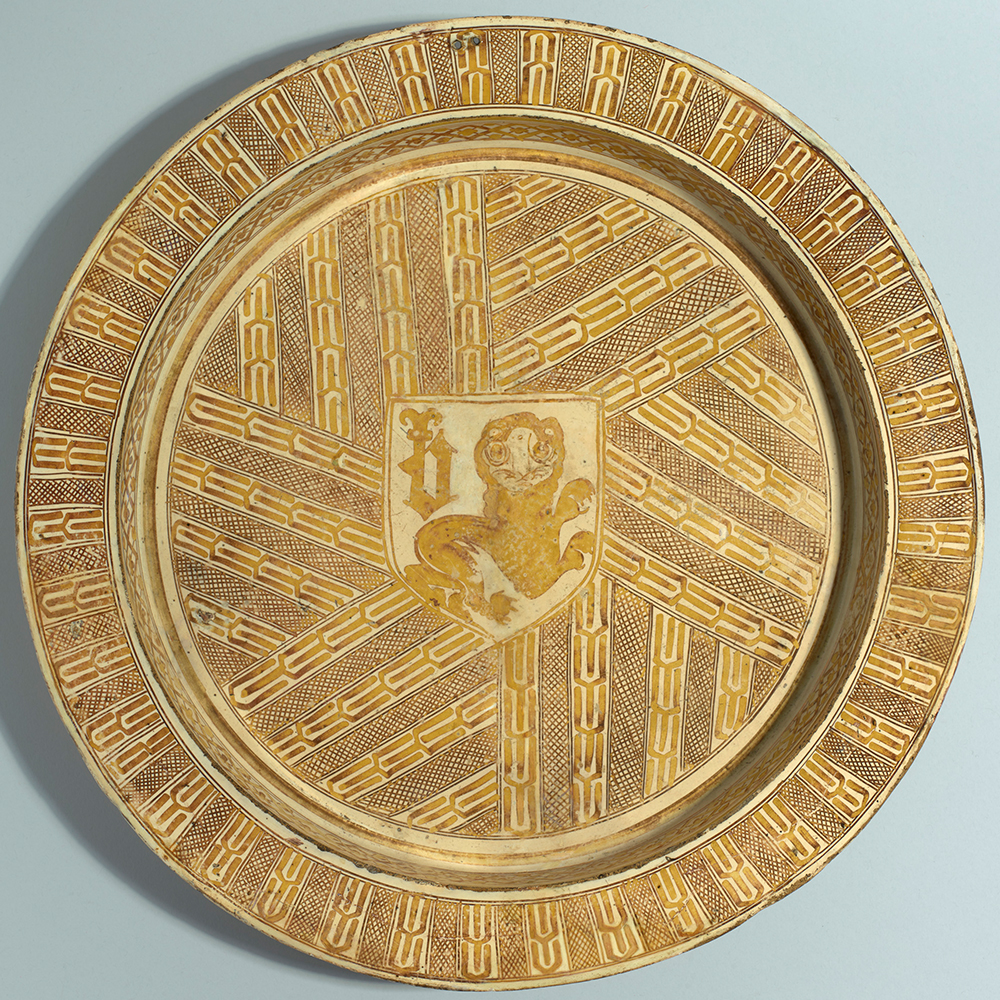Lusterware Plate with Heraldic Device

Mid- to late-15th century
Present-day Spain (Valencia, probably Manises)
Tin-glazed earthenware
Height: 2.3 in (5.7 cm); diameter: 17.5 in (44.5 cm)
Wyvern Collection, 2221
Nestled between sloping groves of olive trees along the banks of the river Turia lies Manises, a small Spanish town with a powerful artistic presence. Known as the primary center of production for lusterware, a type of tin-glazed ceramic developed by Abbasid period Islamic potters (see cat. 27), Manises has dominated the industry since the fourteenth century, and its exports are still highly sought after today. Among them is this armorial plate, a testament to the cultural exchange and stylistic fusion that occurred on the Iberian Peninsula during the seven hundred years when perceived boundaries between “East” and “West” were much more fluid than they are today.
Muslim forces first landed in Gibraltarin 711, conquering Visigothic Iberia and expanding the Umayyad empire into present-day Spain. Though Muslim holdings later fractured into rival states, allowing Christian territories to expand, many southern and coastal regions continued under Muslim rule until the late fifteenth century, and bore witness to profound cultural change. Looking to recreate the splendor they had left behind in Damascus and other eastern cities, Iberian Islamic leaders enriched their kingdoms with untold treasures and sophisticated public infrastructure. Artists, musicians, scholars, poets, and philosophers soon flocked to new cosmopolitan centers, such as Córdoba, Seville, and Málaga, while ports bustled with merchants exchanging luxury goods for local resources. It was within this context of great economic, intellectual, and artistic prosperity that lusterware was initially introduced to Europe. (1)
Western manufacture of the ceramics began in Málaga as early as 1150, inspired by imports from Baghdad, Basra, and Kufa. But throughout the thirteenth century, as Muslims and Christians battled for control and the port city rapidly declined, Málagan master potters migrated north and settled in Valencia, bringing with them their acclaimed gold-lustered craft. In 1251, James I of Aragon had granted Valencian artisans of all religions the right to work freely upon payment of an annual tax and kiln fee, giving rise to a distinctive and collaborative artistic environment. In the workshops of Manises and other nearby towns, Muslim and Christian craftsmen worked side by side, sharing ideas, refining production processes, and creating a style of lusterware entirely their own. (2)
As exemplified by the Wyvern armorial plate, Valencian potters drew on a repertoire of geometric motifs, elaborated in muted browns and reds or brilliant blues and golds, linking their work with Islamic tradition. However, the designs often included coats of arms, and many plates were decorated on the underside with boldly painted animal figures also drawing on European heraldry. Seamless combinations of such elements illustrate the harmonization of Muslim and Christian artistic traditions.
Valencian lusterware occupied a prominent place at the heart of Iberian society. Whether proudly displayed in homes or used as part of a larger table service, as the Wyvern armorial plate once was, the warm colors, metallic sheen, and hybridized conception of the ceramics garnered them unique appreciation throughout all of Europe. Muslims and Christians alike cherished the gold-lustered vessels, a craft that came to belong so indisputably to both cultures it was no longer possible to distinguish between them.
Olivia Muro, Class of 2020
Notes
- Dodds 1992.
- Husband 1970.